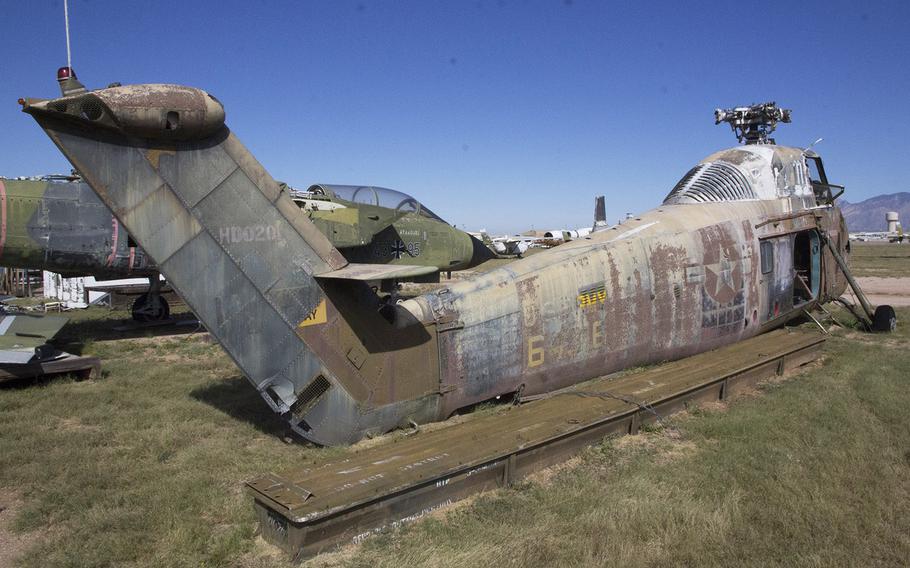
A VH-34C "Choctaw" helicopter at the 309th Aerospace Maintenance and Regeneration Group facility near Tucson, Ariz., in October, 2015. Now owned by the National Museum of the Air Force, it was once part of the Executive Flight Detachment during the Eisenhower administration. (Joe Gromelski/Stars and Stripes)
TUCSON, Ariz. — The 309th Aerospace Maintenance and Regeneration Group started out as a place to store B-29 bombers and C-47 cargo planes after the end of World War II.
Those are gone now, most of them taken apart by demolition teams and a select few surviving to tell the story of their times at museums around the country. The oldest intact aircraft at “the Boneyard” today is a Martin EB-57B Canberra built in 1952.
And time is running out on some other noteworthy planes.
Three years ago, 309 AMARG stopped regenerating stalwarts of the Vietnam War -- F-4 Phantoms -- after processing about 300 of the fighter bombers, some to serve as target drones.
“Once the system program office decided that OK, I’ve got enough parts supportability for the aircraft I have in the field, then I can go ahead and start disposing of these aircraft,” said Shirley Mercier, director of the 577th Commodities and Reclamation Squadron.
But not all the planes at the Boneyard are owned by military units or government agencies. Many are owned by three national museums who use the 4-square-mile dry-weather facility to house planes until space or funding issues can be resolved.
When a smaller museum wants a plane from the Boneyard, it is referred to one of the three: the National Museum of the U.S. Air Force; the National Naval Aviation Museum or the Army’s Center for Military History. “The transfer must then be worked out between the recipient organization and the owning national museum,” said Rob Raine, AMARG’s museum liaison.
The museums handle the restoration once the planes arrive at the Boneyard, and they pay transportation costs from Tucson to the final destination.
When you see a famous plane in a museum, there’s a good chance it spent some time baking in the Arizona sun. Among the alumni aircraft on display around the country are both of the planes that dropped atomic bombs, “Enola Gay” and “Bock’s Car”; the B-24D “Strawberry Bitch”; and Boeing’s “Dash 80,” the 707 prototype famous for doing a barrel roll during its demonstration flight (and now on display at the Smithsonian's Udvar-Hazy Center near Washington, D.C.).
History buffs will mourn the loss of several unique aircraft that were stored at the Boneyard but no longer exist. Among those are the XB-19A heavy bomber (scrapped in 1949); the XA-38 ground attack aircraft “Grizzly” (fate unknown); and the C-87 “Liberator Express” (also scrapped) that carried President Franklin Roosevelt’s envoy Wendell Willkie on a global outreach mission in 1942-1943.
But some famous planes can still be seen at the Boneyard, lined up on Celebrity Row for the enjoyment of those who take bus tours from the nearby Pima Air & Space Museum. Among them: A C-130E that took a shrapnel hit in Vietnam and is now an honorary Purple Heart recipient; two F-4s painted to replicate Vietnam ace Steve Ritchie's plane; one of three existing T-46A Eaglets, and a Boeing YC-14, one of two prototypes of what might have been a replacement for the C-130. (The other YC-14 one is at Pima.)
A different historical aspect of the Boneyard is its role in arms reduction work between the U.S. and Russia. It “serves as a heavy bomber storage and conversion facility under the New Strategic Arms Reduction Treaty and is subject to inspections,” according to 309 AMARG.
Under the 2011 treaty, 39 B-52G bombers were demolished. Here's part of what the treaty stipulates:
“Utilizing a K-12 saw, AMARG Reclamation personnel sever the aft section of the aircraft’s fuselage on a designated circumference cutline drawn between two of the air frame’s production breaks, a strategic cut stipulated by Treaty requirements. The Federation has 60 days to verify the procedure once complete. Elimination verification is accomplished by satellite, referred to in Article X of the treaty as national technical means. After the expiration of the 60-day period, the aircraft is removed from treaty accountability. Total compliance was achieved in December of 2013.”
If you go ...Guided bus tours of The Boneyard leave from the adjacent Pima Air & Space Museum, Monday through Friday (excluding holidays). Times vary by season. Tickets ($7 adults, $4 for 12 and under) are sold on a first-come, first served basis.
According to Meghan Marum of the Arizona Aerospace Foundation, an average of over 27,000 visitors take advantage of the opportunity to ride through the 309 AMARG facility per year.
Get more information here.